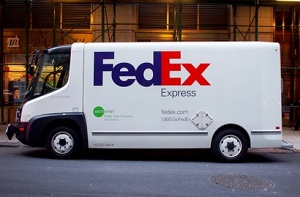Is FedEx the World's Most Sustainable Shipping Company?
 In 2008, FedEx announced an ambitious plan to reduce the carbon emissions intensity of its aircraft and boost the fuel efficiency of its vehicles 20 percent by 2020. Less than four years later, the company not only announced that it has nearly hit those marks, but is setting even more aggressive sustainability targets.
In 2008, FedEx announced an ambitious plan to reduce the carbon emissions intensity of its aircraft and boost the fuel efficiency of its vehicles 20 percent by 2020. Less than four years later, the company not only announced that it has nearly hit those marks, but is setting even more aggressive sustainability targets.The company’s fourth annual Global Citizenship Report reveals FedEx is well on its way to meeting the 20 percent by 2020 goals. The global shipper has reduced its aircraft emissions intensity 13.8 percent and improved vehicle fuel efficiency 16.6 percent by the end of fiscal year 2011 – both ahead of the required pace. In addition, FedEx recycled 47.9 million pounds of waste at its facilities in 2011, an increase of 6.4 million pounds compared to 2011, and launched a carbon-neutral envelope shipping program now being used on more than 200 million shipments annually at no extra cost to consumers.
Not content to rest on its laurels, the company is setting the bar even higher, increasing its aircraft emissions reduction goal 50 percent to a 30 percent overall reduction in 2020 compared to 2005. FedEx will also look to fly its aircraft cleaner, sourcing at least 30 percent of its jet fuel from renewable sources by 2030.
While its progress to date and future goals may seem daunting, the key has been a mantra of “reduce, replace, revolutionize” for fleet management. “We have been constantly on the lookout for those solutions that make sense for the future,” said FedEx executive Mitch Jackson in an interview with GreenBiz. “There’s not a single solution, there’s a series of solutions.”
This mantra has led to wide-scale turnover of the FedEx shipping fleet for more efficient options, starting with aircraft emissions. By 2015, the company will have replaced its older 727 aircraft for more fuel-efficient 757 models, and is introducing Boeing’s 777F aircraft, which is 18 percent more efficient than older models. In addition, more than 30 different programs reduce aircraft fuel consumption and emissions during takeoffs and landings.
FedEx also drove with fewer emissions last year. The company increased the size of its alternative-fuel vehicle fleet 18 percent in FY2012, with 364 hybrid-electric and 118 electric vehicles currently in service. To date, these vehicles have traveled 12.1 million miles and conserved 345,000 gallons of fuel.
Sustainability doesn’t just mean fuel efficiency for the company. FedEx has generated over 18 gigawatt-hours of solar electricity at six solar farms, reducing CO2 emissions an estimated 6,858 metric tons. FedEx also purchased more than 33,000 megawatt-hours of renewable energy credits in FY2011, an effort that has been recognized by the Environmental Protection Agency’s Green Power Partnership program.
Stack it all up, and you get a company that’s actually moving toward a sustainable future instead of just mailing it in. Of course, saving money from fuel boosts the bottom line and there’s a clear business decision to FedEx’s environmental efforts. But with $43 billion in annual revenue and 300,000 employees, the sheer scale of the company’s actions are making a massive difference and setting the pace for all other shipping companies to follow.
You can return to the main Market News page, or press the Back button on your browser.

